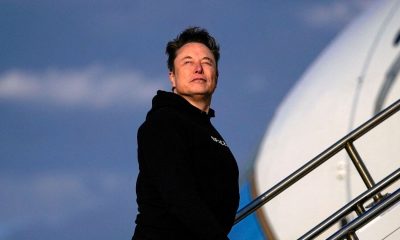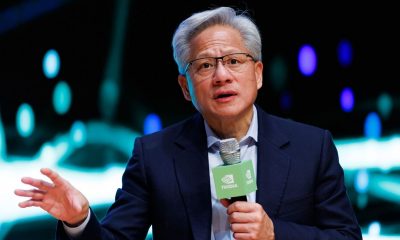

Technology
Can Dixon become India’s Foxconn? – Crypto News
It takes about 20 seconds for a typical air shower—a small room where high velocity air is blown to clean dust—to do its job. That’s close to the time it takes for a single assembly line at the factory to put together a smartphone. This factory, which assembles Motorola phones, has 11 assembly lines, and one line has about 90-100 workers standing next to each other. They make a smartphone like the pieces of a jigsaw puzzle.
View Full Image
It all begins with the liquid display assembly (LDA), an electronic board with a phone’s display on one side, and circuits on the back. The first worker attaches the main printed circuit board (PCB) on the back of this LDA and passes it on to the next worker to connect the PCB to a sub-board at the bottom. In the following steps, camera sensors are attached to the LDA while a robotic machine applies coolant—a glue-like material that keeps phones cool. It takes about 15-20 such steps to assemble a low-end smartphone.
Padget Electronics is a wholly owned subsidiary of Dixon Technologies India Ltd, one of the oldest contract smartphone manufacturers India has had. Even though companies like Dixon have existed since the 1990s, the rise of China’s electronics manufacturing industry led many to forget these firms.
In 2014, research firm Counterpoint Research pegged Micromax (which runs manufacturing firm Bhagwati Products Ltd) as the top smartphone seller in the country. But as Micromax, along with Lava and Intex, disappeared from the market, overrun by Chinese players, people seemed to also forget that they had significant manufacturing businesses.
The pandemic, and changing global geopolitics, however, have brought Indian contract manufacturers back into focus. And few companies have drawn as much attention as Dixon Technologies. Besides Motorola, the company today manufactures smartphones for Nokia and Samsung. Two more contracts are in the works. In 2022-23, it expects revenues at 12,700 crore, nearly double of what the company generated in 2020-21. According to Counterpoint Research, in the September quarter of 2022-23, Dixon accounted for 7.8% of all smartphones made in India, narrowly behind Bharat FIH, which manufactured 8.5% of all devices. Bharat FIH is a Foxconn Technology Group company, one of the world’s largest contract manufacturing entities.
Dixon’s stock underscores the growing importance of Indian contract manufacturing. It rose from around 830 in January 2020 to over 3,859 in May 2022. While the shares have dropped since, many analysts and brokerages remain bullish on the company’s prospects.
What’s driving this optimism?
Brand behind brands
Contract manufacturers like Dixon, Bhagwati and Lava are also called electronics manufacturing services (EMS) providers, which means they take specifications from companies like Motorola and put together an electronic device. Companies such as Motorola, on the other hand, are original equipment manufacturers (OEMs)—they own the original intellectual properties (IPs) and design products. Typically, they contract an EMS company to assemble their product. Some companies, like Samsung, are capable of doing both.
Sunil Vachani, chairman and managing director of Dixon, said his company will never move to the OEM business model. The company, he stressed, wants to remain the “brand behind the brands”. In doing so, it will never become a competitor to the companies it produces for. A Motorola, therefore, will never have to worry about handing Dixon a contract because It knows that the company won’t use what it learns from manufacturing Motorola products to create a competing and possibly cheaper product—which is essentially how Chinese companies like BBK Electronics, Xiaomi and many others became giants in the field of consumer electronics over the past. decades.
In a way, the strategy is similar to Taiwanese Foxconn’s famed eCMMS business model. While the ‘e’ is simply technology parlance, CMMS stands for component, module, move and service. It explains how Foxconn established itself as a manufacturing giant by making acquisitions that gave the company more control over the ecosystem, and hence, allowed it to offer better pricing.
Foxconn began as a plastic component provider specializing in connector and cable production back in the 1970s. It expanded through the 1980s, 1990s and 2000s to evolve into a complete system integrator for large companies, including Apple. It did so by slowly acquiring control over the labor intensive parts of the industry, and by acquiring capabilities in putting together PCBs, and various other modules of an electronic device.
Similarly, Vachani is keen on getting a handle on components electronics devices use. The company, he said, will be analyzing the Budget proposal on halving customs duties on open cell panels—a key ingredient for making televisions (TV)—and will also start injection molding for TV frames soon.
In the December quarter, the company also completed technology acquisition of Bluetooth mesh technology (a connectivity standard that allows multiple devices to interact with each other) and new WiFi solutions for smart lighting from Ibahn Illumination, a lighting solutions company.
The new factories
What financial investors like in a manufacturing business is how you differentiate yourself,” said a person who was among Dixon’s original investors and exited when the company went public in 2017. He didn’t want to be identified. He added that this differentiation can come either by becoming a market leader or if the firm can expand the market opportunity for itself.
Dixon is doing the second. Mobile phones are only one part of its business. The company also assembles products in consumer electronics, home appliances, medical electronics, lighting solutions, set-top boxes, IT hardware, and reverse logistics. Expansion means building more factories. Vachani said the company is building five.
The first factory, which will manufacture telecom equipment, is ready. The second factory, which will be dedicated to manufacturing wearable products (smartwatches, true wireless headphones, etc.) will become operational in March. Yet another will be used to manufacture refrigerators and will become operational by April. The fourth factory is Dixon’s largest at one million square feet. It will be dedicated to the manufacturing of mobile phones and is expected to be ready by August-September this year. The last factory will come up in Andhra Pradesh on a 20-acre plot and will be dedicated to manufacturing surveillance products, like security cameras.
Meanwhile, Dixon announced a joint venture with Bharti Airtel in April 2021 to manufacture telecom and networking products such as routers and modems. While consumer electronics already generate substantial revenues ( 864 crore in the December quarter of 2022-23 with operating profit of 26 crore), Vachani has identified refrigerators as a growth area. Wearables is another bet, as will be laptops—once the government announces a production linked incentive (PLI) scheme for the sector. The scheme provides companies cash incentives on incremental production.
During its January 2023 earnings call, Saurabh Gupta, Dixon’s CFO, said that the company has “big growth” coming in all verticals in 2023-24. He added that fully automatic washing machines could show 100% growth, while wearables, hearables, telecom and TV could grow between 15% and 18%.
In September 2022, Dixon became the first firm to receive benefits—worth 53 crore—from the PLI scheme for mobile phones. In fact, no less than five of Dixon’s manufacturing segments are set to receive PLI benefits—besides phones, there is IT hardware, lighting, washing machines and telecom.
“They (Dixon) have been here for more than two decades,” said Tarun Pathak, research director at Counterpoint Research. “They have all the ingredients to scale up in house. They are scaling at the right place, at the right time. And then, obviously, looking at exports as an opportunity as well,” he added.
Vachani agreed, noting that the company aims to earn nearly 1,200 crore from exports in future. Exports are not significant at the moment but, going ahead, the company expects to ship mobile phones and lighting products, among others. While the US is the key export market right now, Dixon plans to expand to Africa and the Middle-East as well.
From EMS to ODM
In the early 2000s, companies like HCL, Wipro, Zenith and ALTOS among others had tried to develop a complete ecosystem for personal computer manufacturing in India. Industry veterans recalled how governments didn’t pay heed at the time, dismissing them as “screwdriver companies”. It was among the biggest mistakes Indian governments made, they held. The Modi government’s focus on building India as a manufacturing alternative to China must not go the same way. That goal can only be achieved if firms like Dixon move from the EMS model to what is called an original design manufacturing (ODM) model.
“Manufacturing as a paradigm relentlessly chases low cost,” said PVG Menon, a veteran consultant for the electronics industry. “If you want to broaden this, we should learn from China on how to make it sticky. You add value by deepening the ecosystem and by adding design capability. Offer ready-made modules with which products can be quickly realised,” he added.
ODMs lie somewhere between OEMs and EMS firms. ODMs own key licenses and IPs required to manufacture electronic products and appliances. To be sure, the transition to being an ODM is unlikely to make a big difference to Dixon’s margins. However, it allows a contract manufacturer more freedom and better visibility into its own business. For instance, in September, Dixon announced that it had acquired licenses to Android and GoogleTV platforms for televisions from Google.
Vachani said that the company plans to launch its first India certified design for televisions in the first quarter of 2023-24. He also said that the company already has ODM status in lighting and washing machine segments, and it hopes to achieve the same status in the telecom business in the next financial year.
Challenges and growth
Dixon, however, isn’t immune to a global slowdown or the electronics industry’s supply chain nightmare. In the January earnings call, Dixon noted that two new mobile phone contracts are in the works, but, at the same time, demand for Motorola phones had dropped, which led the company to revise its estimates.
A sub-par December quarter has led the firm to revise its growth estimates for 2022-23. While Dixon was earlier expected to generate revenue of 16,500-17,000 crore, the estimates have now moderated to 12,200- 12,700 crore.
Analysts said that the two new mobile phone customers Dixon is set to acquire could be key to the company’s growth.
An analyst from a top securities firm, who didn’t want to be identified, said that the guidance revision, along with the market downturn globally, has cost Dixon some points. “The thinking among some investors is that Dixon might be struggling to allocate funds to the right areas efficiently. Smaller rivals can move fast into growth areas,” the analyst said.
Companies such as MEPL (Sky Electronics), Sun Industries Pvt Ltd, ELIN Electronics, NTL Electronics, Vimal Plast India, etc., are competing with Dixon in different markets—from televisions and lighting products to home appliances. In mobile phones, the company’s biggest competitors are Bharat FIH and Lava.
The analyst quoted above, however, does not believe that the smaller firms pose a great risk. They don’t have the scale advantage Dixon has amassed over the past few years and may struggle for capital.
“You have to understand that Dixon remains one of the largest EMS players in India. Its only real competition is Foxconn. Lava, Bhagwati, etc., can’t expand to other segments fast enough. So, there’s no reason not to remain bullish on Dixon,” the analyst said.
Certainly, investors would like to see the company as India’s answer to Foxconn.
Catch all the Technology News and Updates on Live Mint. Download Mint News App to get Daily market update Live business news,
-
Cryptocurrency1 week ago
Robinhood Lists HYPE As Hyperliquid Flips Aster, Lighter In Perp DEX Volume – Crypto News
-

 Metaverse1 week ago
Metaverse1 week agoTech layoffs: From Meta, Amazon to Google — these IT majors have cut AI related jobs – Crypto News
-

 Blockchain1 week ago
Blockchain1 week agoAfrica Countries Pass Crypto Laws to Attract Industry – Crypto News
-
Cryptocurrency1 week ago
XRP News: Ripple Unveils ‘Ripple Prime’ After Closing $1.25B Hidden Road Deal – Crypto News
-
Business1 week ago
Peter Schiff Challenges Binance Founder CZ to Debate as Bitcoin Vs. Gold Rivalry Heats Up – Crypto News
-

 De-fi1 week ago
De-fi1 week agoAster Rallies on ‘Rocket Launch’ Incentives Campaign – Crypto News
-

 Cryptocurrency1 week ago
Cryptocurrency1 week agoTrump plans to pick Michael Selig to lead CFTC: Report – Crypto News
-

 Blockchain1 week ago
Blockchain1 week agoISM Data Hints Bitcoin Cycle Could Last Longer Than Usual – Crypto News
-
others7 days ago
JPY soft and underperforming G10 in quiet trade – Scotiabank – Crypto News
-

 De-fi7 days ago
De-fi7 days agoNearly Half of US Retail Crypto Holders Haven’t Earned Yield: MoreMarkets – Crypto News
-

 Technology1 week ago
Technology1 week ago‘It just freezes’: Spotify users fume over app crashes on Android devices, company responds – Crypto News
-

 Cryptocurrency1 week ago
Cryptocurrency1 week agoDOGE to $0.33 in Sight? Dogecoin Must Defend This Key Level First – Crypto News
-
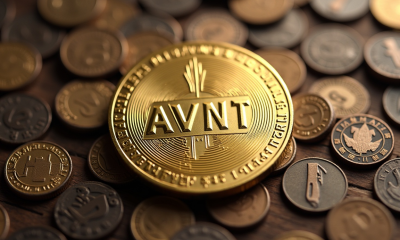
 Cryptocurrency1 week ago
Cryptocurrency1 week agoWhat next for Avantis price after the 73% recovery? – Crypto News
-

 Technology1 week ago
Technology1 week agoNothing OS 4.0 Beta introduces pre-installed apps to Phone (3a) series: Co-founder Akis Evangelidis explains the update – Crypto News
-

 Blockchain7 days ago
Blockchain7 days agoEthereum Rebounds From Bull Market Support: Can It Conquer The ‘Golden Pocket’ Next? – Crypto News
-

 Blockchain6 days ago
Blockchain6 days agoXRP Price Gains Traction — Buyers Pile In Ahead Of Key Technical Breakout – Crypto News
-

 Technology4 days ago
Technology4 days agoSam Altman says OpenAI is developing a ‘legitimate AI researcher’ by 2028 that can discover new science on its own – Crypto News
-

 Metaverse1 week ago
Metaverse1 week agoBezos fund believes AI can save the planet. Nvidia, Google are all-in. – Crypto News
-
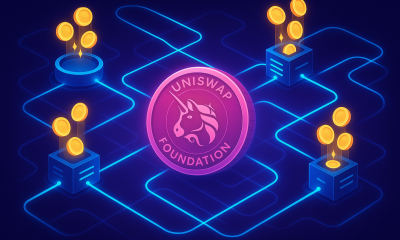
 Technology1 week ago
Technology1 week agoUniswap Foundation (UNI) awards Brevis $9M grant to accelerate V4 adoption – Crypto News
-

 Technology1 week ago
Technology1 week agoFrom Studio smoke to golden hour: How to create stunning AI portraits with Google Gemini – 16 viral prompts – Crypto News
-

 Blockchain1 week ago
Blockchain1 week agoBinance Stablecoin Outflow On A Steady Rise — What This Means For The Market – Crypto News
-

 De-fi7 days ago
De-fi7 days agoHYPE Jumps 10% as Robinhood Announces Spot Listing – Crypto News
-
others7 days ago
Platinum price recovers from setback – Commerzbank – Crypto News
-

 Cryptocurrency6 days ago
Cryptocurrency6 days agoWestern Union eyes stablecoin rails in pursuit of a ‘super app’ vision – Crypto News
-
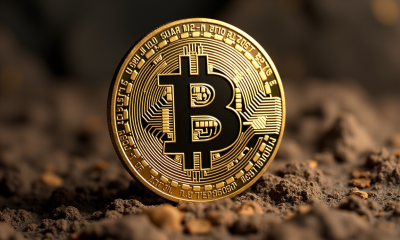
 Cryptocurrency1 week ago
Cryptocurrency1 week agoCrypto update: Bitcoin and Ethereum are stable as market’s focus shifts to US inflation data – Crypto News
-

 De-fi1 week ago
De-fi1 week agoSolana DEX Meteora Launches Native MET Token – Crypto News
-

 Technology1 week ago
Technology1 week agoGoogle and Apple face extra UK scrutiny over strategic role in mobile platforms – Crypto News
-
Business1 week ago
White House Crypto Czar Backs Michael Selig as ‘Excellent Choice’ To Lead CFTC – Crypto News
-
others1 week ago
JPY weak and underperforming – Scotiabank – Crypto News
-
Business1 week ago
Breaking: Trump To Meet China’s President On October 30, Bitcoin Bounces – Crypto News
-

 Cryptocurrency6 days ago
Cryptocurrency6 days agoUSDJPY Forecast: The Dollar’s Winning Streak Why New Highs Could Be At Hand – Crypto News
-

 Cryptocurrency1 week ago
Cryptocurrency1 week agoLedger Nano Gen5 feels like Flex for less – Crypto News
-

 Cryptocurrency1 week ago
Cryptocurrency1 week agoFetch.ai and Ocean Protocol move toward resolving $120M FET dispute – Crypto News
-

 Metaverse1 week ago
Metaverse1 week agoGemini in Gmail automates meeting schedules effortlessly – Crypto News
-

 Blockchain7 days ago
Blockchain7 days agoEntire Startup Lifecycle to Move Onchain – Crypto News
-

 Cryptocurrency7 days ago
Cryptocurrency7 days agoNEAR’s inflation reduction vote fails pass threshold, but it may still be implemented – Crypto News
-

 Blockchain6 days ago
Blockchain6 days agoXRP/BTC Retests 6-Year Breakout Trendline, Analyst Calls For Decoupling – Crypto News
-
others6 days ago
Indian Court Declares XRP as Property in WazirX Hack Case – Crypto News
-

 Technology6 days ago
Technology6 days agoSurvival instinct? New study says some leading AI models won’t let themselves be shut down – Crypto News
-
others6 days ago
Is Changpeng “CZ” Zhao Returning To Binance? Probably Not – Crypto News
-

 Technology1 week ago
Technology1 week agoSolana’s RWA market surpasses $700M all-time high as adoption accelerates – Crypto News
-

 Cryptocurrency1 week ago
Cryptocurrency1 week agoJito’s JTO token rises on a16z’s $50 million investment in Solana staking protocol – Crypto News
-
Technology1 week ago
Dogecoin Price Crash Looms as Flag, Death Cross, Falling DOGE ETF Inflows Coincide – Crypto News
-

 Blockchain1 week ago
Blockchain1 week agoBitcoin Whale From 2009 Moves Coins After 14 Years Asleep – Crypto News
-

 Technology1 week ago
Technology1 week agoOpenAI announces major Sora update: Editing, trending cameos, and Android launch on the way – Crypto News
-
Business1 week ago
HBAR Price Targets 50% Jump as Hedera Unleashes Massive Staking Move – Crypto News
-
Business1 week ago
PEPE Coin Price Prediction as Weekly Outflows Hit $17M – Is Rebound Ahead? – Crypto News
-

 Cryptocurrency1 week ago
Cryptocurrency1 week agoHYPE Breaks Out After Robinhood Listing and S-1 Filing: What’s Next? – Crypto News
-
Technology1 week ago
Analyst Eyes Key Support Retest Before a Rebound for Ethereum Price Amid $93M ETF Outflows and BlackRock Dump – Crypto News
-
Business1 week ago
Ripple Explores New XRP Use Cases as Brad Garlinghouse Reaffirms Token’s ‘Central’ Role – Crypto News







